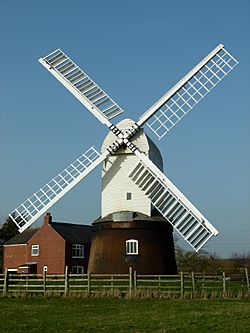Wrawby Windmill facts for kids
Quick facts for kids Wrawby Windmill |
|
|---|---|

Wrawby Windmill, March 2014
|
|
| Origin | |
| Coordinates | 53°33′55″N 0°27′08″W / 53.56528°N 0.45222°W |
| Year built | Late 18th century |
| Information | |
| Purpose | Corn mill |
| Type | Midlands post mill |
| Roundhouse storeys | Single storey roundhouse |
| No. of sails | Four |
| Type of sails | Two Common sails, two Spring sails (previously four Spring sails) |
| Winding | Tailpole |
The Wrawby Postmill is a historic windmill located in Wrawby, a village near Brigg in North Lincolnshire, England. It is a special type of windmill known as a post mill.
This mill is very important because it is the last working post mill in the north of England. It was built a long time ago, sometime between 1760 and 1790. Its main job was to grind corn for the nearby Elsham Hall estate.
Contents
History of Wrawby Windmill
Building the Mill
The Wrawby Postmill was constructed in the late 1700s. It was designed to grind grain into flour. This was a vital task for local farms and communities.
How the Sails Changed
When it was first built, the mill had four "common sails." These were simple, traditional sails. Over time, its sails were changed to a mix of two common sails and two "spring sails." Spring sails were more flexible and could handle different wind conditions better. By the 1940s, the mill was using four spring sails.
Saving the Mill
The mill stopped working in the 1940s and became very run down. It was almost torn down! But in 1962, a group called the Wrawby Windmill Preservation Society stepped in. They bought the mill to save it.
The society worked hard to restore the mill. By 1965, it was working again. New sails and grinding stones were installed. More maintenance was done in 2008. This work helped the mill return to using mixed sail types. Funds for this came from the SPAB Mill Repairs Fund and local people.
Visiting the Mill Today
The Wrawby Postmill is still working and is open for visitors. It's a great place to learn about how windmills operate.
What You Can See
Inside the mill, there is a small museum. It displays old tools that were used for milling. You can also watch demonstrations to see how the mill grinds grain. This shows you how people used to make flour long ago.
Historical Importance
The windmill is recognized as a very important historical building. In 1951, it was given a Grade II* listing. This means it is a particularly important building of more than special interest.
External links
- Wrawby Postmill - Visit Lincolnshire
- National Mills Weekend: Wrawby Windmill

